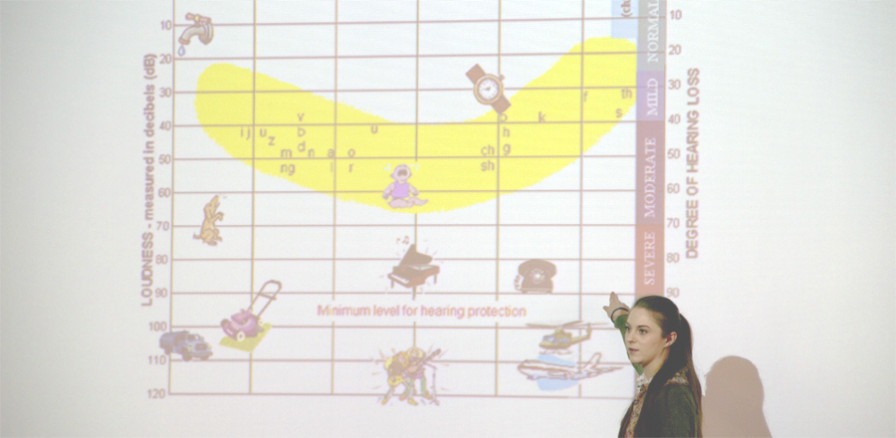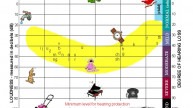Music Makes Lives Better Because... it's just as important for D/deaf/F people

You might be (mistakenly) of the mind that D/deaf/F people cannot possibly enjoy or even experience music. D/deaf/F people (particularly hearing-impaired children and young people) can experience huge benefits from both listening to music and taking part in music making.
Before we go any further, we'd like to explain why we use the term "D/deaf/F". In order to recognise the choice of those who have a hearing impairment to be represented in the way that they wish to be, we acknowledge that deafness can be categorised in different ways. Small letter deaf is a medical definition, describing the physiological characteristic of being deaf. Deaf with a capital D is a cultural definition, describing a whole culture of Deafness that many deaf people identify as being a part of. DeaF with capitals D and F is a social definition, choosing to embrace a fluid identity that encompasses the other two definitions and more.
When we think about hearing loss, most of us initially assume that it is an all or nothing situation – we are either able to hear or we aren’t… But this just isn’t the case.
Take a look at the graph at the bottom of this page, sent to us by one of the professional musicians we work with, Eloise Garland. Eloise is an accomplished musician, and a teacher. She plays the violin, she sings… and she also happens to have significant hearing loss:
The graph image attached is called the 'Speech Banana' and gives an idea of the various objects / living creatures displayed and the frequency and volume at which they make sound. Some people can hear most of this spectrum, those with profound hearing loss can hear only parts of it.
As Eloise has already explained to our colleagues at Wakefield Music Service, as part of a series of training sessions to instruct music service staff on how to engage with D/deaf/F children in lessons (part of our Deaf Young People and Instrumental Learning project), hearing loss occurs on a spectrum and differs from person to person. Most D/deaf/F or hearing-impaired people have some level of hearing ability, just as some people can hear higher or lower frequencies of sound than others – it all depends on the individual.
This means that most people who have profound hearing loss can still hear and / or feel the vibrations of music can learn to understand the different fluctuations produced by different notes, for example. They can hear and feel rhythms and can understand texture, pacing and nuance.
Now, you may be asking: does it take extensive specialist knowledge to include children and young people with hearing impairments in music making? The answer is no, and it doesn’t take much of an adjustment from ordinary working practices either. Simple steps, such as tapping a D/deaf/F child on the shoulder to get their attention (or flicking the light on and off if you can’t touch them), demonstrating how to hold and blow instruments using visual cues, learning some simple sign language (to describe each note from letter A to G) are all very simple ways to begin to engage young D/deaf/F people in music lessons. Have a look at our resources for more information and guidance on how to engage D/deaf/F young people in music making and take a look here for specifics on communicating with D/deaf/F children in teaching situations.
In fact, as well as providing lots of information about how teachers can work with D/deaf/F kids, YY&M (with the support of Eloise, Sean Chandler, Ruth Montgomery and Paul Whittaker OBE) has helped D/deaf/F children around the region to access instrumental music lessons with their local music service and participate in singing and signing choirs and ensembles alongside their hearing peers. We’ve also offered training with D/deaf/F musicians to staff in schools and music hubs, giving them some tools and tips on how to be more inclusive in their existing sessions.
So… are we the experts then? No, we’re not – we know much more than we did, but that doesn’t equate to lived experience as a D/deaf/F person. But because we don’t know what it is like to experience music as a D/deaf/F person, we ask the people who DO know, and we ask them to lead our initial sessions, often providing the D/deaf/F children we encounter with role models that they didn’t know existed – professional musicians who happen to have a hearing impairment (just like them).
D/deaf/F people can – and do – enjoy and play music (many to proficient levels). It doesn’t take much adaptation to existing music lessons to invite D/deaf/F young people in and encourage them to become musicians themselves… so let’s start integrating these simple steps into ALL mainstream music education.
If you are unsure on how to begin, contact us. We know who to ask…
-----
‘Music Makes Lives Better’ is Yorkshire Youth and Music’s slogan, and is fitting for the work we do with children in challenging circumstances. Music is obviously important for human connection the world over; it is a language that is truly universal. Our series of articles titled ‘Music Makes Lives Better because...’ digs deep each month into the reasons we do what we do here at YY&M. We look at music education from a unique perspective and invite you, our readers, to explore these ideas with us. Please visit www.yym.org.uk to find out more about what we do.



